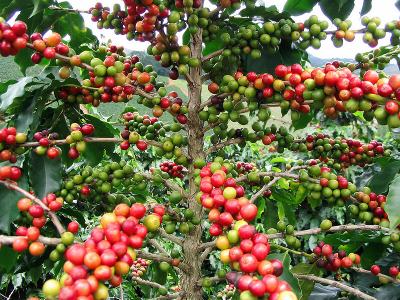A correct understanding of the practice of Didi pot coffee in Vietnam to understand the production, history and culture of Vietnamese coffee
On this trip to the border between China and Vietnam, I tasted this Vietnamese Didi pot coffee for the first time in Puzhai. When the boss brought this kind of coffee, I was a little at a loss.
Vietnamese coffee originated from drip-filtered coffee which was very popular in France in the early 19th century and was introduced into Vietnam with the colonial relationship between France and Vietnam. Vietnamese coffee is not brewed in a coffee pot, but a special dripping coffee cup, which we call a dripping pot.
The Vietnamese Didi pot is very small and does not need to change the filter paper. It uses the natural infiltration of hot water to extract coffee. Because it has the strong characteristics of French dripping coffee, it is also very suitable for making iced coffee. As long as you put ice cubes and the right amount of condensed milk in the glass and let the coffee drop directly on the ice cubes, it is a well-known cup of Vietnamese iced coffee.
The coffee style of Vietnam lies largely in its brewing process, which is followed by an old-fashioned printed glass, just like an hourglass in timing, spending every drop of time. When you do it, put the coffee powder on the drip pot on the cup holder below, press a piece of metal with holes, and then brew it with hot water to let the coffee drip into the cup. When making hot coffee, keep the cup warm in a large bowl filled with boiling water, because it may take three to ten minutes to drip a cup of coffee, and the hot coffee will cool off. Some people like to add a layer of sweet condensed milk under the cup, wait for the coffee to drop into the cup, and then mix the coffee with white condensed milk to drink. Only those who can bear the patience will wait until a cup of coffee has been dripped, then drink it slowly and appreciate the beauty of slow life.
I feel that I have a strong replication function, which I have to admire myself, and I am easily fond of certain things. Once I am interested, I will dive into it and cannot extricate myself. Some are scary, and some are out of control, this is me.
It was only after the Spring Festival that I began to play coffee. The time was very short and there was no research, so when my boss brought this thing, I was a little confused and was ridiculed by YET. It doesn't matter if I don't understand. I'll study hard with the powerful Baidu later. I played with it exactly the same as soon as I came back.
The method of using Vietnam Didi pot to make coffee
Raw material: about 15 grams of coffee powder (moderate depth will be more suitable for our taste, grinding needs to be moderately fine, too coarse grinding may make the dripping speed too fast, and too fine grinding will not only produce scorched smell, but also make a lot of residue in the cup.)
Hot water (above 90 degrees) is about 200ml.
Condensed milk is about 20ml (can be increased or decreased according to your own taste, or not added)
Production steps:
1. Pour hot water into the coffee cup
2. Remove the first filter from the Vietnam pot, and then add coffee powder to the pot.
3. Shake the coffee powder flat, put the first strainer back, and then turn it tight. Don't twist it too tight.
4. Pour out the hot water in the coffee cup, add condensed milk, and place the Vietnamese pot on the coffee cup.
5. Pour a little water, which refers to the standard of soaking coffee powder but not dripping water.
This step is also used in follicular coffee, the technical term "steaming", after 20 seconds or so, put about 90 degrees of water, cover the lid
6. Place for about 3 minutes, remove the Vietnamese pot after the drip filtration is completed, and drink if there is condensed milk stirred slightly.
Source:
Zhou Zhou loves Zhou Zhou's blog
Important Notice :
前街咖啡 FrontStreet Coffee has moved to new addredd:
FrontStreet Coffee Address: 315,Donghua East Road,GuangZhou
Tel:020 38364473
- Prev

The oldest coffee tree species, the coffee culture you don't know, the mysterious world of coffee.
Do you know what is the oldest kind of coffee tree? Baitianhui Coffee training School shares coffee culture with you. Many factors affecting coffee cultivation are largely related to the variety of coffee, and there are great differences between regions. Arabica (arabica) is the oldest coffee tree. Arabica is a high-growing variety, usually grown in mountains, plateaus, or
- Next

What are the factors that affect Italian concentration?
1. Coffee astringency is manifested as: after drinking coffee, the throat is dry, astringent, astringent and miscellaneous. When I swallow coffee, I feel uncomfortable in my throat. Second, the three manifestations of coffee extraction: As mentioned in the previous article, coffee is water passing through coffee powder, bringing out the soluble substances in coffee powder, and we get a cup of coffee. And everything we regulate
Related
- What is the meaning of lactic acid fermentation with coffee bean treatment?
- How to judge the state of foam by sound?
- How does the latte pull out the unicorn pattern? Come to get for a little trick to improve the flower pull!
- Will flower pulling affect the taste of the latte?
- Do you know the history of coffee?
- The difference between honey treatment and sun washing what is raisin honey treatment?
- What kind of milk can a novice use to make coffee foam to keep the foam longer? The correct method and skills of milking tutorial sharing
- Why do washed coffee beans taste sour? Flavor characteristics of washed Coffee
- Introduction to the skill of how to practice the size and height of water injection around the circle of hand-brewed coffee
- How do beginners practice coffee flower drawing from scratch?

